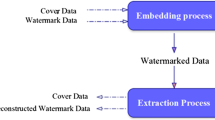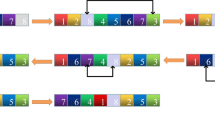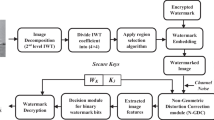Abstract
Data hiding in digital multimedia has been extensively used for sensitive data transmission and data authentication. An important property of data hiding which makes this method applicable to such applications is its fragility. The fragility is the loss of the embedded authentication credential resulting from any tampering attempt. Another important issue in data hiding and watermarking in digital images is increasing the embedding capacity while keeping the quality of the cover image high enough to avoid any perceptual degradation. In this paper a novel fragile digital image data hiding algorithm based on Lattice Vector Quantization (LVQ) is proposed to solve the above mentioned shortcomings. In the proposed data hiding algorithm after an initial pre-processing stage, the image is transformed into frequency domain using Integer-to-Integer Discrete Wavelet Transform (IIDWT). Then lattice vector quantization of A4 and Z4 lattices are used for embedding data into the cover image. The proposed embedding algorithm has the ability to hide the data inside the entire cover image. The experimental results show that the proposed data hiding algorithm performs significantly better than recently proposed algorithms when the embedding capacity is increased. At the high capacity regimes, the proposed algorithm can embed significantly more sensitive data in the cover image while keeping the perceptual quality of the recovered image high.






Similar content being viewed by others
References
Akhtarkavan E (2012) Multiple-description lattice vector quantization for image and video coding based on coinciding similar sublattices of An, in School of Electrical and Electronics. Univesiti Sains Malaysia: http://ee.eng.usm.my/eeacad/fadzli/abstract/Phd-06-12-Abstract.pdf. p. 169.
Akhtarkavan E, Majidi B, Manzuri MT (2019) Secure communication and archiving of low altitude remote sensing data using high capacity fragile data hiding. Multimed Tools Appl 78(8):10325–10351
Akhtarkavan E, Salleh MFM (2010) Multiple description lattice vector quantization using multiple A4 quantizers. IEICE Electronics Express 7(17):1233–1239
Akhtarkavan E, Salleh MFM (2010) Multiple description lattice vector quantization using multiple A4 quantizers. IEICE Electronics Express 7(17):1233–1239
Akhtarkavan E, Salleh MFM (2011) Multiple descriptions coding for H.264/AVC using coinciding A2 lattice vector quantizer. in 2011 IEEE International Conference on Signal and Image Processing Applications (ICSIPA)
Akhtarkavan E, Salleh MFM (2012) Multiple descriptions coinciding lattice vector Quantizer for wavelet image coding. IEEE Trans Image Process 21(2):653–661
Akhtarkavan E, Salleh M (2012) Multiple Descriptions Coinciding Lattice Vector Quantizer for H. 264/AVC and Motion JPEG2000, in Advanced Video Coding for Next-Generation Multimedia Services, Y.-S. Ho, Editor, Electronics and Telecommunications Research Institute IntechOpen: South Korea
Akhtarkavan E, Salleh M, Sidek O (2013) Multiple descriptions video coding using coinciding lattice vector Quantizer for H. 264/AVC and motion JPEG2000. World Appl Sci J 21(2):157–169
Baake M, Heuer M, Moody RV (2008) Similar sublattices of the root lattice A4. Journal of Algebra 320(4):1391–1408
Chang I-C et al (2015) High capacity reversible data hiding scheme based on residual histogram shifting for block truncation coding. Signal Process 108:376–388
Coatrieux G et al (2013) Reversible watermarking based on invariant image classification and dynamic histogram shifting. IEEE Transactions on Information Forensics and Security 8(1):111–120
Conway JH, Rains EM, Sloane NJA (1999) On the existence of similar sublattices. Can J Math 51:1300–1306
Conway JH, Sloane NJA (1982) Voronoi regions of lattices, second moments of polytopes and quantization. IEEE Trans on Information Theory 28(2):211–226
Conway JH, Sloane NJA (1982) Fast quantizing and decoding and algorithms for lattice quantizers and codes. IEEE Trans on Information Theory 28(2):227–232
Conway JH, Sloane NJA (1998) Sphere Packings, Lattices and Groups, 3rd edn. Springer-Verlag, New York
Das C et al (2014) A novel blind robust image watermarking in DCT domain using inter-block coefficient correlation. AEU-International Journal of Electronics and Communications 68(3):244–253
Ding H et al (2018) High Quality Data Hiding in Halftone Image Based on Block Conjugate. Chin J Electron 27(1):150–158
Dragoi IC, Coltuc D (2016) Adaptive pairing reversible watermarking. IEEE Trans Image Process 25(5):2420–2422
Fan D-P et al (2018) Salient objects in clutter: Bringing salient object detection to the foreground. in Proceedings of the European Conference on Computer Vision (ECCV)
Fan, D.-P., et al., Rethinking rgb-d salient object detection: models, datasets, and large-scale benchmarks. 2019.
Gersho A, Gray RM (2003) Vector quantization and signal compression, 9th edn. Kluwer Academic Publishers, Amsterdam
Goyal VK, Kelner JA, Kovacevic J (2002) Multiple description vector quantization with a coarse lattice. IEEE Trans Inf Theory 48(3):781–788
Gunjal BL, Mali SN (2015) MEO based secured, robust, high capacity and perceptual quality image watermarking in DWT-SVD domain. SpringerPlus 4(1):126
Hong W, Chen T-S, Shiu C-W (2009) Reversible data hiding for high quality images using modification of prediction errors. J Syst Softw 82(11):1833–1842
Hossain MS, Muhammad G (2016) Cloud-assisted industrial internet of things (iiot)–enabled framework for health monitoring. Comput Netw 101:192–202
Hua G et al (2019) Random matching pursuit for image watermarking. IEEE Transactions on Circuits and Systems for Video Technology 29(3):625–639
Hwang HJ et al (2010) Reversible watermarking method using optimal histogram pair shifting based on prediction and sorting. KSII Transactions on Internet and Information Systems (TIIS) 4(4):655–670
Kalra GS, Talwar R, Sadawarti H (2015) Adaptive digital image watermarking for color images in frequency domain. Multimed Tools Appl 74(17):6849–6869
Li X, Li B, Yang B, Zeng T (2013) General framework to histogram-shifting-based reversible data hiding. IEEE Trans Image Process 22(6):2181–2191
Li X et al (2013) A novel reversible data hiding scheme based on two-dimensional difference-histogram modification. IEEE Transactions on Information Forensics and Security 8(7):1091–1100
Li X et al (2015) Efficient reversible data hiding based on multiple histograms modification. IEEE Transactions on Information Forensics and Security 10(9):2016–2027
Li M et al (2019) Fidelity preserved data hiding in encrypted highly autocorrelated data based on homomorphism and compressive sensing. IEEE Access 7:69808–69825
Li Y et al (2019) A high-imperceptibility and histogram-shifting data hiding scheme for JPEG images. IEEE Access 7:73573–73582
Linde Y, Buzo A, Gray R (1980) An algorithm for vector quantizer design. IEEE Trans on Communications 28(1):84–95
Liu Y et al (2019) DNA: Deeply-supervised Nonlinear Aggregation for Salient Object Detection
Mallat SG (1989) A theory for multiresolution signal decomposition: the wavelet representation. IEEE Trans on Pattern Analysis and Machine Intelligence 11(7):674–693
Mohanty SP et al (2017) Everything you want to know about watermarking: from paper Marks to hardware protection: from paper marks to hardware protection. IEEE Consumer Electronics Magazine 6(3):83–91
Nguyen TV, Patra JC (2008) A simple ICA-based digital image watermarking scheme. Digital Signal Processing 18(5):762–776
Ou B, Li X, Zhao Y, Ni R, Shi YQ (2013) Pairwise prediction-error expansion for efficient reversible data hiding. IEEE Trans Image Process 22(12):5010–5021
Pan Z, Wang L (2018) Novel reversible data hiding scheme for two-stage VQ compressed images based on search-order coding. J Vis Commun Image Represent 50(50):186–198
Patra JC, Karthik A, Bornand C (2010) A novel CRT-based watermarking technique for authentication of multimedia contents. Digital Signal Processing 20(2):442–453
Patra JC, Phua JE, Bornand C (2010) A novel DCT domain CRT-based watermarking scheme for image authentication surviving JPEG compression. Digital Signal Processing 20(6):1597–1611
Piper A, Safavi-Naini R (2013) Scalable fragile watermarking for image authentication. IET Inf Secur 7(4):300–311
Qin C, Hu Y-C (2016) Reversible data hiding in VQ index table with lossless coding and adaptive switching mechanism. Signal Process 129:48–55
Rahmani P, Dastghaibyfard G (2018) An efficient histogram-based index mapping mechanism for reversible data hiding in VQ-compressed images. Inf Sci 435(435):224–239
Rahmani P, Dastghaibyfard G (2018) Two reversible data hiding schemes for VQ-compressed images based on index coding. IET Image Process 12(7):1195–1203
Sachnev V et al (2009) Reversible watermarking algorithm using sorting and prediction. IEEE Transactions on Circuits and Systems for Video Technology 19(7):989–999
Shehab A et al (2018) Secure and robust fragile watermarking scheme for medical images. IEEE Access 6:10269–10278
Shi YQ et al (2016) Reversible data hiding: advances in the past two decades. IEEE Access 4:3210–3237
Shirafkan MH, Akhtarkavan E, Vahidi J (2015) A image steganography scheme based on discrete wavelet transform using lattice vector quantization and reed-solomon encoding. in 2015 2nd International Conference on Knowledge-Based Engineering and Innovation (KBEI)
Shukla AK et al (2018) A secure and high-capacity data-hiding method using compression, encryption and optimized pixel value differencing. IEEE Access 6:51130–51139
Singh AK, et al (2016) Digital image watermarking: techniques and emerging applications, in Handbook of research on modern cryptographic solutions for computer and cyber security. IGI Global. p. 246–272
Su Q, Chen B (2018) Robust color image watermarking technique in the spatial domain. Soft Comput 22(1):91–106
Sweldens W (1998) The lifting scheme: a construction of second generation wavelets. SIAM J Math Anal 29(2)
Vaishampayan VA, Sloane N, Servetto S (2001) Multiple description vector quantization with lattice codebooks: design and analysis. IEEE Trans on Information Theory 47:1718–1734
Wang C, Li X, Yang B (2010) Efficient reversible image watermarking by using dynamical prediction-error expansion, in 2010 IEEE International Conference on Image Processing. p. 3673–3676.
Weber G (1993) USC-SIPI image database: Version 4. Dept. Elect. Eng.-Syst., Univ. Southern California, Los Angeles, CA, USA, Tech. Rep, 244
Weng S et al (2019) Improved K-pass pixel value ordering based data hiding. IEEE Access 7:34570–34582
Zheng S, Wang Y, Hu D (2019) Lossless Data Hiding Based on Homomorphic Cryptosystem. IEEE Transactions on Dependable and Secure Computing:1
Author information
Authors and Affiliations
Corresponding author
Additional information
Publisher’s note
Springer Nature remains neutral with regard to jurisdictional claims in published maps and institutional affiliations.
Rights and permissions
About this article
Cite this article
Akhtarkavan, E., Majidi, B., Salleh, M.F.M. et al. Fragile high capacity data hiding in digital images using integer-to-integer DWT and lattice vector quantization. Multimed Tools Appl 79, 13427–13447 (2020). https://doi.org/10.1007/s11042-020-08662-7
Received:
Revised:
Accepted:
Published:
Issue Date:
DOI: https://doi.org/10.1007/s11042-020-08662-7




